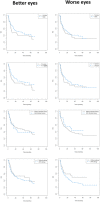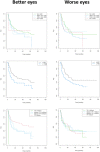Natural history and predictors for progression in pediatric keratoconus
- PMID: 36973341
- PMCID: PMC10042985
- DOI: 10.1038/s41598-023-32176-5
Natural history and predictors for progression in pediatric keratoconus
Abstract
We studied the demographic and clinical predictors associated with keratoconus progression in a pediatric population. Retrospective cohort study. We evaluated 305 eyes without previous surgeries from 168 patients, 9 to < 18 years old, and with a minimum 36-month follow-up in a hospital corneal ambulatory. We used Kaplan-Meyer survival curves; the dependent variable (main outcome measure) was the interval time (months) until the event, defined as an increase of 1.5 D in the maximum keratometry (Kmax), obtained with Pentacam. We evaluated the predictors: age (< or ≥ 14 years), sex, keratoconus familial history, allergy medical history, and the baseline tomographic parameters: mean keratometry (Km), Kmax (< or ≥ 55 D); and thinnest pachymetry (TP). We used log-rank tests and compared median survival times for right (RE)/left eyes (LE) and better (BE)/worse eyes (WE). A p value < 0.05 was considered significant. The patients' mean ± SD age was 15.1 ± 2.3 years old; 67% were boys, 30% were < 14 years, 15% had keratoconus familial history, and 70% were allergic. The general Kaplan-Meyer curves showed no differences between RE/LE or BE/WE. RE with allergy and LE with Kmax ≥ 55 D had smaller survival times ((95%CI 9.67-32.1), p 0.031 and (95%CI 10.1-44.1), p 0.042, respectively). For BE and WE, Kmax ≥ 55 D had smaller survival times ((95% CI 6.42- ), p 0.031 and (95%CI 8.75-31.8), p 0.043, respectively). Keratoconus progression was similar between RE/LE and BE/WE. Steepest corneas are predictors of faster progression. Allergy is also a predictor of keratoconus progression in RE.
© 2023. The Author(s).
Conflict of interest statement
The authors declare no competing interests.
Figures






Similar articles
-
Keratoconus Progression After Corneal Cross-Linking in Eyes With Preoperative Maximum Keratometry Values of 58 Diopters and Steeper.Cornea. 2018 Nov;37(11):1444-1448. doi: 10.1097/ICO.0000000000001736. Cornea. 2018. PMID: 30157048
-
The Outcome of Corneal Collagen Cross-Linking in Patients with Advanced Progressive Keratoconus: A 2-Year Follow-up Study.Middle East Afr J Ophthalmol. 2019 Jan-Mar;26(1):11-16. doi: 10.4103/meajo.MEAJO_101_18. Middle East Afr J Ophthalmol. 2019. PMID: 31114118 Free PMC article.
-
Accelerated versus standard corneal collagen cross-linking in pediatric keratoconus patients: 24 months follow-up results.Cont Lens Anterior Eye. 2018 Oct;41(5):442-447. doi: 10.1016/j.clae.2018.06.001. Epub 2018 Jun 15. Cont Lens Anterior Eye. 2018. PMID: 29910023
-
Transepithelial versus epithelium-off corneal crosslinking for progressive keratoconus.Cochrane Database Syst Rev. 2021 Mar 23;3(3):CD013512. doi: 10.1002/14651858.CD013512.pub2. Cochrane Database Syst Rev. 2021. PMID: 33765359 Free PMC article.
-
Corneal collagen cross-linking: a review of 1-year outcomes.Eye Contact Lens. 2014 Nov;40(6):345-52. doi: 10.1097/ICL.0000000000000094. Eye Contact Lens. 2014. PMID: 25343263 Review.
Cited by
-
Utility of artificial intelligence in the diagnosis and management of keratoconus: a systematic review.Front Ophthalmol (Lausanne). 2024 May 17;4:1380701. doi: 10.3389/fopht.2024.1380701. eCollection 2024. Front Ophthalmol (Lausanne). 2024. PMID: 38984114 Free PMC article.
-
Progression and regression of keratoconus in an Iranian population.Sci Rep. 2025 Aug 5;15(1):28525. doi: 10.1038/s41598-025-08296-5. Sci Rep. 2025. PMID: 40764499 Free PMC article.
-
The association between upper tarsal conjunctiva appearance and corneal biomechanical weakening in refractive surgery candidates.Sci Rep. 2025 Apr 28;15(1):14793. doi: 10.1038/s41598-025-00122-2. Sci Rep. 2025. PMID: 40295504 Free PMC article.
References
Publication types
MeSH terms
Substances
LinkOut - more resources
Full Text Sources
Medical

